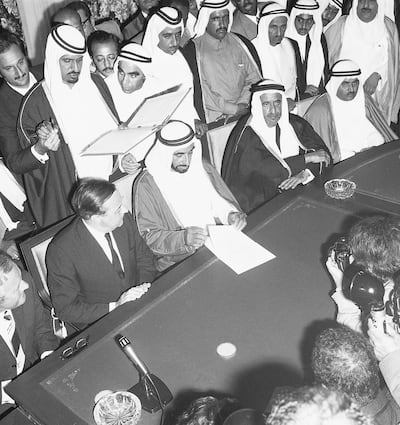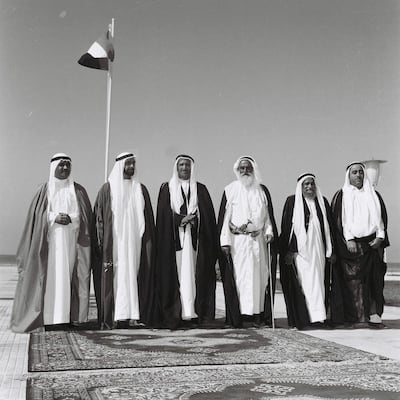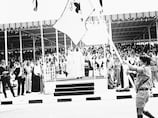They met like tribal chieftains, Bedu-style, in a simple tent in the desert at a place that marked the border of their two domains.
When it was over, a momentous decision had been made on the strength of a simple handshake: the emirates of Abu Dhabi and Dubai would come together as one people and one country.
It was February 18, 1968, when Sheikh Zayed, Ruler of Abu Dhabi, and Sheikh Rashid bin Saeed, Ruler of Dubai, reached a formal agreement that would bind them together and lead to the formation, three years later, of the United Arab Emirates.
The moment of their decision, though, was anything but formal, marked by the growing friendship between the two men and their respect for each other.

Sheikh Mohammed bin Rashid, Vice President and Ruler of Dubai, recalled the meeting in a series of tweets in 2018.
“From that day we started, from that day we agreed and from that day we began our march together,” he said.
Then a young man not yet 20, and newly graduated from officer training at a UK military academy, Sheikh Mohammed recalled the exchange between his father and the UAE Founding Father.
“So Rashid, what do you think? Shall we create a union?” Sheikh Zayed asked the older of the two Rulers.
“Give me your hand, Zayed,” Sheikh Mohammed recalls his father replying. “Let us shake upon the agreement. You will be President.”
“Fifty years are nothing in the age of a country, but with Zayed every year was worth 50 in work and achievements,” Sheikh Mohammed bin Rashid said on Twitter.
“Our nation remembers this day so as not to forget our beginnings and not to forget good intentions and to stay aware that we are of the desert, we began there and we have reached space.”
What led to the unification between Abu Dhabi and Dubai?
The meeting 57 years ago was held in Seih Al Sedira, a small hill on the Abu Dhabi side of the border and close to the community of Al Sameeh, now grown in size and bisected by the E11 on the approach to Ghantoot.
The road to Al Sameeh, though, had been anything but straightforward. Less than a month earlier, the cash-strapped socialist Labour government of the UK, had, without warning, decided to withdraw from the Arabian Gulf, a sphere of British influence for more than 100 years.
Britain’s departure, to take place by the end of 1971, would end a series of treaties in which the old Empire agreed to defend what were then known as the Trucial States in exchange for control over their foreign relations.
As Britain’s warships and fighter aircraft departed, the seven emirates, along with Bahrain and Qatar, would be left to fend for themselves.
Without protection from a major power, they would face many potential enemies, namely Iran, which claimed the islands of Abu Musa and the Greater and Lesser Tunbs, belonging to Sharjah and Ras Al Khaimah respectively, and all of Bahrain.
This was the background to the February meeting between Abu Dhabi and Dubai. Even the location was a minor diplomatic triumph, given that the border between the two emirates had only recently been fixed and, indeed, had been the subject of several past disputes.
The atmosphere on that February day, though, was cordial. The gathering was small, in two tents; one for private meetings between the two Rulers, the other for hospitality. As the youngest member of the party, it was the duty of Sheikh Mohammed to serve the coffee.
The two Rulers had already met several times previously, most recently in January, when Sheikh Zayed offered to fund a number of infrastructure projects with Abu Dhabi’s new oil wealth, including the first paved road between the two emirates.
Now the stakes were even higher, but the objective also clearer. After the two leaders departed, a joint communique was issued, bearing both their signatures. It stated, briefly, that it was the intention of the two emirates to join together, with a common policy on foreign affairs and defence. It invited others to join them.
How the seven emirates came together to form the UAE
One week later, a much larger gathering took place in Dubai. All seven emirates were represented, along with Bahrain and Qatar. After two days of intense meetings and discussions, a broader agreement was reached.

A new country would be created from the nine, to be called the Union of Arab Emirates, while preparations would begin for a draft constitution.
A statement was issued: “The Union of Arab Emirates comprises one people, and has one policy, one diplomatic representation, one army and one economic and social structure.”
“The organisational structure of the Union is democratic, its official religion is Islam, the source of its legislation is Islamic Law, its official language is Arabic and its people is part of the Arab nation.”
Many challenges still lay ahead. Bahrain and Qatar eventually decided to go their own ways. Iran continued to press its claim over the disputed islands, eventually occupying both the Tunbs and Abu Musa. Ras Al Khaimah was initially hesitant about joining the new country, eventually doing so as the seventh emirate in early 1972.
There were internal discussions and complications as well. What currency would be used? Where would the capital be? Would the individual emirates retain their own military forces? What would be the extent of federal controls over areas like education and taxes?
They are familiar issues to anyone who has studied the recent history of the European Union, or even the Gulf Co-operation Council.
Dr Fatima Al Sayegh, professor of history at UAE University, has described the period between 1968 and December 1971 as "the most difficult in the history of the union. It witnessed long and difficult negotiations, sometimes reaching a deadlock".
But, she added: “The Al Sameeh meeting, hence, marked the beginning of a golden era in the history of the region. It paved the way for the establishment of a unique country that has become a model in various areas of development.”
This story was first published by The National for the UAE's 50th National Day in 2021.








